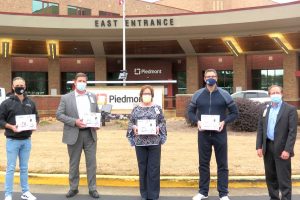A 19th century Torah scroll, which once belonged to a synagogue in what is now the Czech Republic, has been restored to kosher condition and can once again be read at worship services on special occasions at Congregation B’nai Israel (CBI), a Reform Jewish synagogue in Fayetteville.
CBI first obtained what it calls its Holocaust Torah in April 1984 on permanent loan from the Westminster Torah Trust in England. That scroll is one of about 1800 that were moved in 1942 to Prague’s Central Jewish Museum from synagogues that had been destroyed or abandoned in Bohemian and Moravian communities because of the Nazi occupation. Surprisingly, Nazi authorities agreed to permit the transfer.
Jews in Prague were moved to act because the Torah is the primary holy scripture of Judaism, and tradition says it was given by God to Moses on Mt. Sinai in the 14th century B.C. The scroll contains the hand-inscribed Hebrew text of the first five books of the Bible — Genesis, Exodus, Leviticus, Numbers and Deuteronomy. A Torah portion is read at every Sabbath service so that the entire Torah is heard during the course of a year.
More than 700 laws prescribe how a Torah scroll is to be created and maintained. It must be written with a quill by certified sofers (the Hebrew term for scribes) who are trained for ordination through an apprenticeship process. Parchments on which text is written must be made from kosher animal skin (such as cattle or deer), and the ink is produced by only four or five Israeli companies using a formula that is a closely held secret.
In Prague, specialists meticulously catalogued the recovered Torah scrolls, creating card files that had a description of each one and its former home. There they remained until 1964, when more than 1500 of them were purchased from what was then the Czech Communist government and moved to the Westminster Synagogue in London. Some are still there in what is now known as the Czech Memorial Scrolls Museum, but many have been sent to congregations around the world, including CBI, on a permanent loan basis.
The Holocaust Torah was the only one CBI had until the congregation commissioned a new one that went into use in January 1998. Before then, synagogue leaders worried about the frail condition of the older scroll, which is believed to be at least 120 years old.
In January of this year, CBI arranged for restoration work based on an inspection by Rabbi Moshe Druin of Sofer on Site, an organization in North Miami Beach, Fla., that does Torah restoration work and many other Torah-related projects in the U.S. and abroad. Druin confirmed that the scroll badly needed repairs and thus was no longer kosher.
This past week, Rabbi Yochanan Salazar, a master sofer also with Sofer on Site, arrived at CBI and began a two-day restoration job. He worked in the synagogue’s sanctuary, where the Holocaust scroll was unrolled on long tables set up in front of the bimah, a raised platform used by participants in services. He paused long enough last Wednesday afternoon and evening to explain his task to congregants and other visitors and to answer their questions. On Thursday he worked non-stop, starting at 8:30 a.m. and winding up about 3 p.m.
Susan Burden, cantorial soloist at CBI, said Salazar explained that the main problems he had to address were the Torah’s age, composition of the original ink, normal wear and tear, and some previous less acceptable repairs.
“His main task,” Burden said, “was restoration of text in several types of situations—by inking in parts of letters that had faded, cracked, pulled away or disappeared; by completely rewriting letters that were missing or unreadable; by patching the parchment in areas where the letter could not be re-lettered successfully on the existing parchment; and by restoring letters in areas that had been less successfully repaired in the 1990s.”
Salazar also told Burden that more restoration may be necessary as some presently acceptable areas may become unreadable in the future through the aging process. Under its permanent loan agreement, CBI must have the Holocaust Torah inspected every five years.
Burden said the Fayetteville synagogue’s historic Torah and others that were created before 1890 are the last of their kind because of the script, written using both Sephardic (Spanish-North African) and Ashkenazic (French-German) lettering; the quality of the parchment; and the lack of standard column widths and line delineations found in more modern scrolls. Furthermore, the scribes who created them and who were taught these styles died in the Holocaust without passing along their distinctive skills.
“A scribe is permitted only to produce the style of text and writing that he has been taught by his teacher or mentor,” Burden said. “Even though he might be able to copy another style, he is not permitted to do so. Our Torah thus becomes more special, and we as a congregation become the caretakers of an amazing piece of our history, a connection point for us all between our past and our future as Jews.”












Leave a Comment
You must be logged in to post a comment.